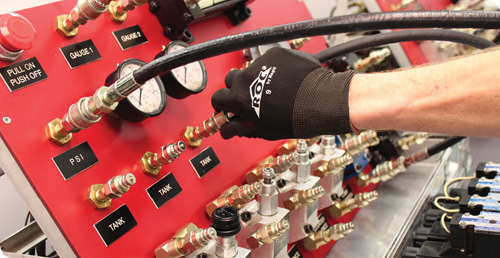By J. Eric Freimuth, Hydraulic Training Associates
Most fluid power literature is written for product information only, despite the fact that the sale of fluid power components in the world market is in the billions. Hydraulics has little recognition for being an occupational hazard. Hydraulics is not recognized as a licensed trade nor listed as an occupation, however 25% of occupations are exposed to hydraulics.

Understanding the hazards of all high-pressure hydraulic systems, such as hose use and maintenance, is critical to ensure safety for your personnel.
Safety knowledge and respect for the hazards of hydraulics can only be gained through training and mentoring; however, the practice of “learn as you go” is an unacceptable way to gain hydraulic safety knowledge. Even though electrical components meet standards, when they are assembled into a circuit, the circuit must be inspected to meet codes of the local jurisdiction. For hydraulic circuits there are no inspections required—nor are there any bodies that carry jurisdiction or authority to do so.
Many occupations, such as heavy equipment mechanics, equipment operators, electricians, pipe fitters, loggers and fisherman, work with hydraulic equipment and components daily. Millwrights and heavy-equipment mechanics are the closest recognized trades that incorporate the study of hydraulics in trade schools, and yet mechanics in 25% of occupations are subject to stored energy daily. Of the licensed trades, millwrights and heavy-equipment mechanics may have the highest exposure to hydraulic systems, followed by operators, pipe fitters, electricians and ironworkers.
A solid hydraulic safety awareness program is the only way to bring awareness of hydraulic hazards in all areas of the discipline. Courses should touch on the following areas of importance, each area having sections that relate to any piece of equipment or system:
- health and exposure
- ethics and standards
- hoses
- stored energy
- threads and porting
- seals
- safety devices
- bleed down
- mechanics and geometry
- welding
- hazard assessment
- beyond lock-out
- environment
- ethics
For example, in the first section, health and exposure, courses should cover the following:
- What are hydraulic fluids?
- What are the three most common types of hydraulic fluid used in systems today?
- What are the things that should be considered when exposed either through penetration or fluid spray?
- What are the four main hazards associated with hydraulic fluid?
- How can you ensure that the personal protective equipment you have is compatible with specific hazards?
In the end, the best way to prevent exposure to hydraulic fluids is to avoid them as much as possible.
By ignoring or neglecting the hazards of stored energy, we are allowing our workers to be subjected to potential injury or even death. Knowledge of the components is vital to understanding how they work, but the understanding of the dangers will help to prevent these injuries if we pursue the training and safety briefings along with the others safety meetings companies have every day.
Isn’t it time we address this subject to all operators and mechanics working around stored energy daily? Training is available to assist companies in developing proper hydraulic safety understanding of stored energy.
Hydraulic Training Associates
htahydraulics.com
Filed Under: Fluid Power World Magazine Articles